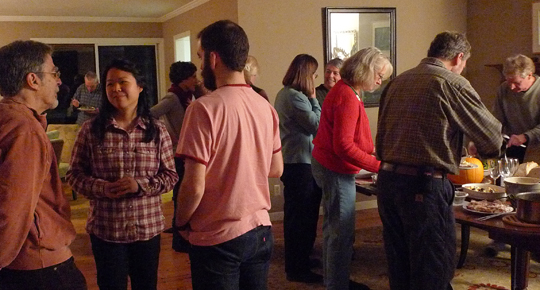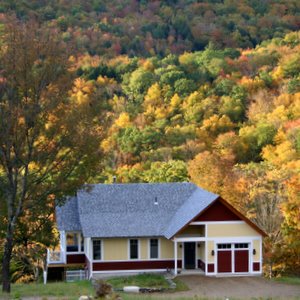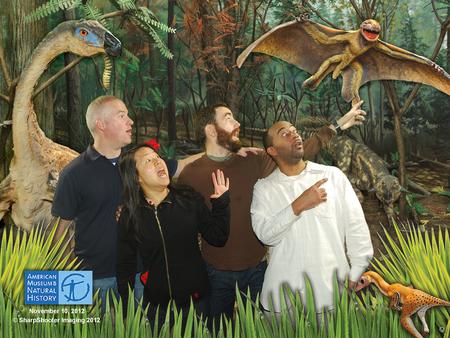During our travels, there have been so many individual segments. Sometimes, like in Taiwan, we mostly do the same thing for three months. Other times, like in Japan, we have whole new experiences every few days. In a perfect world, we would love to have a blog post about every single discrete experience, and beyond that, we’d love to have the posts all published within just a few days of the events happening. As you can easily tell, that rarely happens perfectly with us! But, we keep plugging away, posting on our blog, because we want to document it for ourselves, and especially because of how many times people have told us they are following our blog.
Of course some trips get missed on our blog entirely. One such trip is our hike on the Kumano Kodo pilgrimage trail in Japan, which for both of us was one of the highlights of our entire year of travel. Thankfully our forever-memorable Couch Surfing host Mayuko recently reminded us to post about it, because she will soon be hiking on the trail herself.

Want to be surrounded by idyllic scenes like this for a few days? Then hike the Kumano Kodo.
What is the Kumano Kodo, you ask? To Wikipedia!
The Kumano Kodō (熊野古道?) is a series of ancient pilgrimage routes that crisscross the Kii Hantō, the largest Peninsula of Japan. These sacred trails were and are still used for the pilgrimage to the sacred site “Kumano Sanzan” (熊野三山), or the Three Grand Shrines of Kumano: Kumano Hongū Taisha (熊野本宮大社), Kumano Nachi Taisha (熊野那智大社) and Kumano Hayatama Taisha (熊野速玉大社). The Kumano Kodō pilgrimage routes that lead to Kumano can be geographically categorized into three sub-routes: “Kiji”, “Kohechi” and “Iseji”. The Kumano Kodō and Kumano Sanzan, along with Koyasan and Yoshino and Omine, were registered as UNESCO World Heritage on July 7, 2004 as the “Sacred Sites and Pilgrimage Routes in the Kii Mountain Range”.
We took the train down from Kyoto to Kii Tanabe, where we had a great small-town start to our adventures. The hostel we stayed at directed us to a little sushi restaurant where we were treated like old friends. They even rung the bells for good luck when we departed!
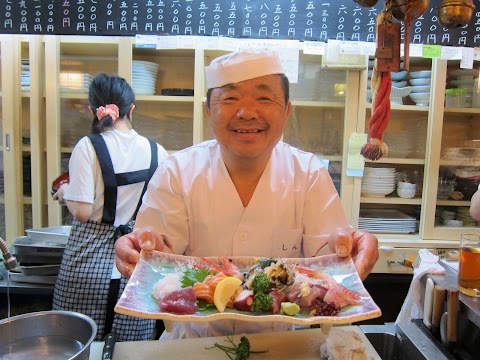
The best sushi chef/owner at Shinbe Resturant makes us a platter of octopus, abalone, tuna, salmon, shrimp, halibut, and other delicacies.
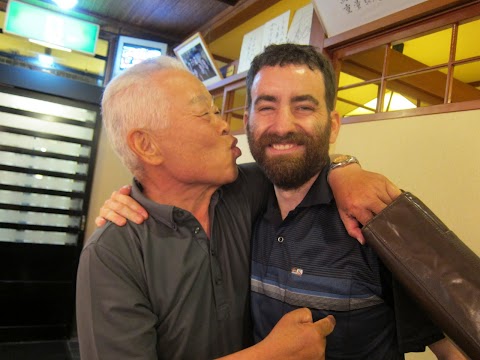
Stu makes friends with Tanabe locals in Shinbe
The next morning, we picked up a scheduled bus from the Kii-Tanabe train station to the Kumano Kodo trail head. Incredibly, we got lost within the first couple of hours, but as far as I can remember it was our only major mistake. Having lost an hour or two, we got back on track and hiked through to Chikatsuyu-Oji. If you’re hiking the Kumano Kodo, you’ll want to print and study these maps ahead of time.
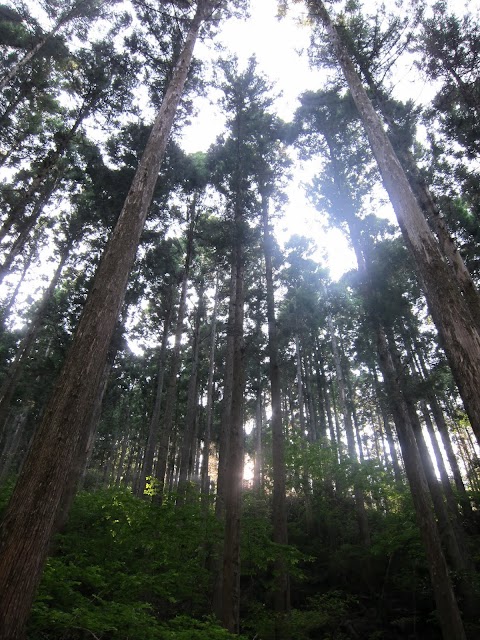
absolutely gorgeous forests
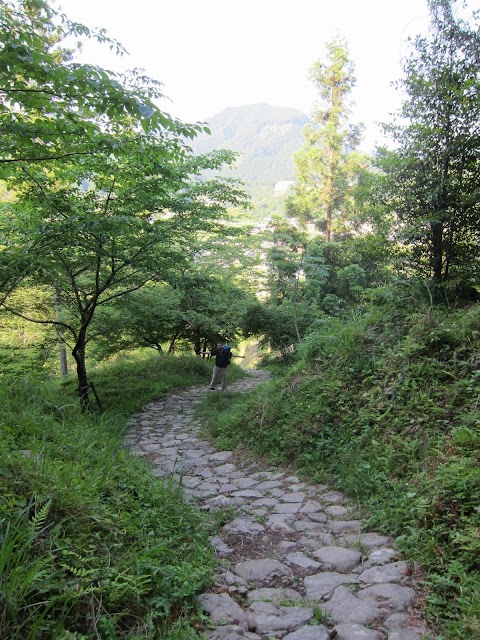
Cute stone paths straight from The Shire but rough on your feet over time.
The first day was rough, but arrive we did at Chikatsuyu-Oji. I don’t think they were exactly expecting any travelers, but they were no less accommodating. We didn’t see any indication as to where we should sleep for the night, so we walked into a little corner store to ask… in English, and about ten words of Japanese. Thankfully, among a group of men hanging out inside, there was one very helpful man with a very helpful translation app on his phone. He was so kind to make a phone call to ask about sleeping accommodations for us, drive us to the grocery store for food, and then drive us to the bath house, which had one room for overnight guests.
It was our most basic accommodations of the Kumano Kodo, but no less comfortable, and certainly beautiful.
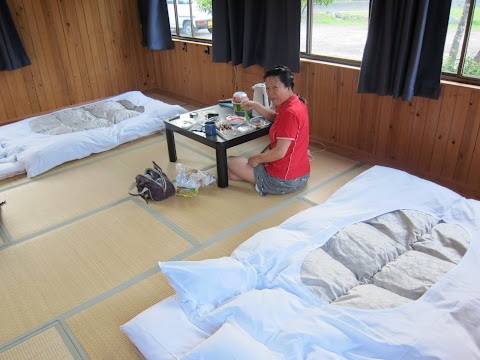
Tatami floors, futons, and a water heater. Adjacent to the bath house. Perfect!

The views from this mountain town bathhouse were incredible.
The next day was our most difficult day of hiking. We hiked 14 miles to arrive at Yunomine Onsen. (See the pink trail on this map.) Many times Mags wished she was a goat or other ungulate on the trail.
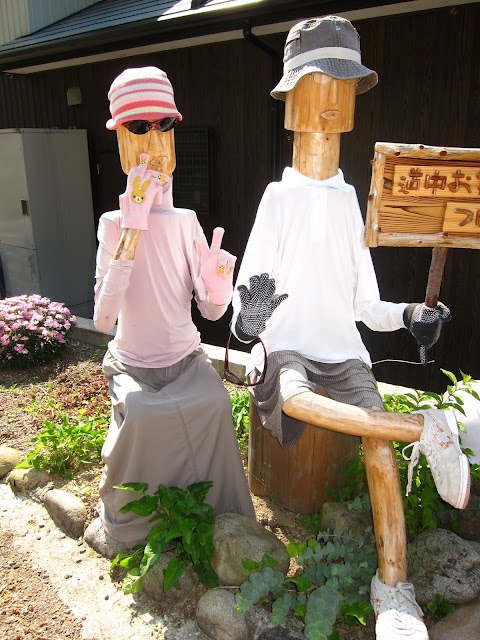
We met this nice couple along the way who provided us with kind words of encouragement.
Right after we passed by these wooden people, we saw some red-faced gray monkeys in the trees. They howled and growled, sounding a lot like the howler monkeys in Belize! It was too difficult to get a good picture of them from afar, and we didn’t know how to ask them to come closer in Japanese.
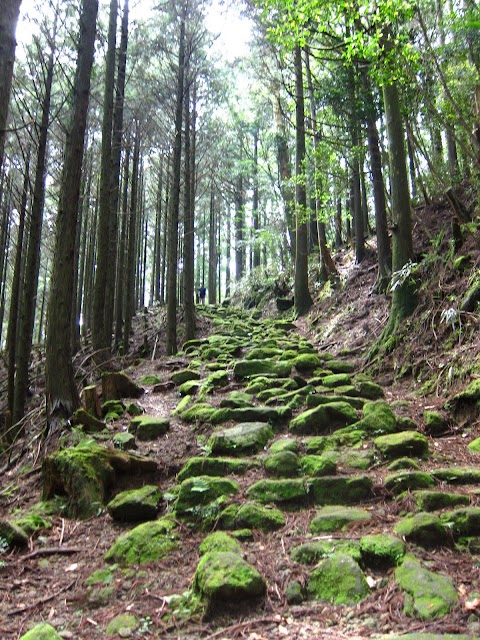
Miles of stone path looked like this. At times the path turned into a seasonal stream. Watch your step on moss covered rocks!
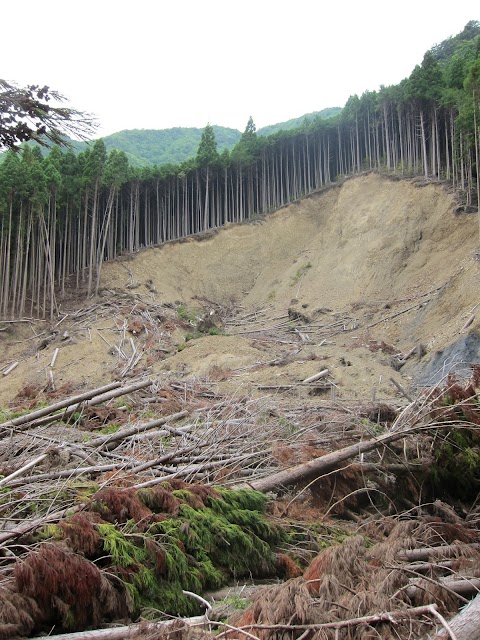
Of course most of the views are beautiful, but we also came across this sad sight of a clear-cut monoculture tree plantation which gave way to erosion.
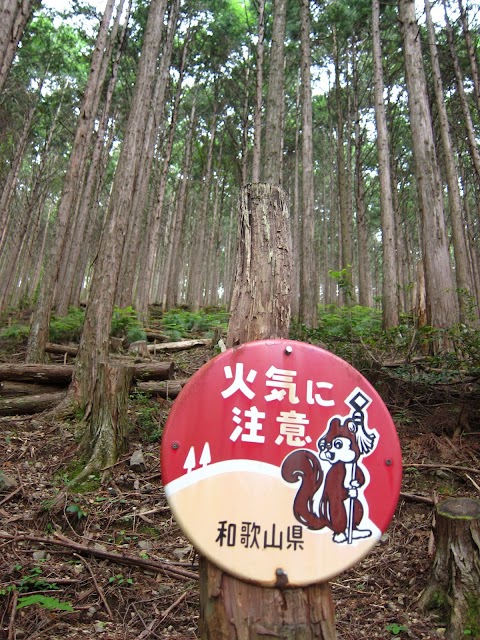
Do not disobey this chipmunk. He guards against forest fires.
As our weary feet landed at Yunomine Onsen, we sat down on the curb for a moment to decide our next move. A man from the onsen across the street came and greeted us, and we didn’t have to think for very long before we decided to stay there for the night. This was the most luxurious night of our Kumano Kodo trip. There were baths inside and out, and the town had a steaming hot stream running through the middle of it. We ate soba, and eggs cooked in the hot spring for dinner, and soaked multiple times in the hot baths.
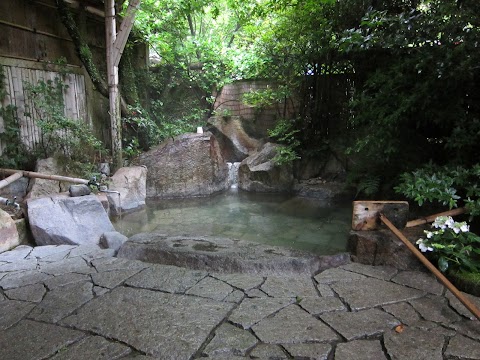
Outdoor hot spring bath. You can see the greenish hue of the mineral waters.
After the excruciating hike from the day before, and on account of the day’s rain, we opted to continue on for a day by bus. We arrived at our first grand shrine of the trip, the Kumano Hongu Taisha.
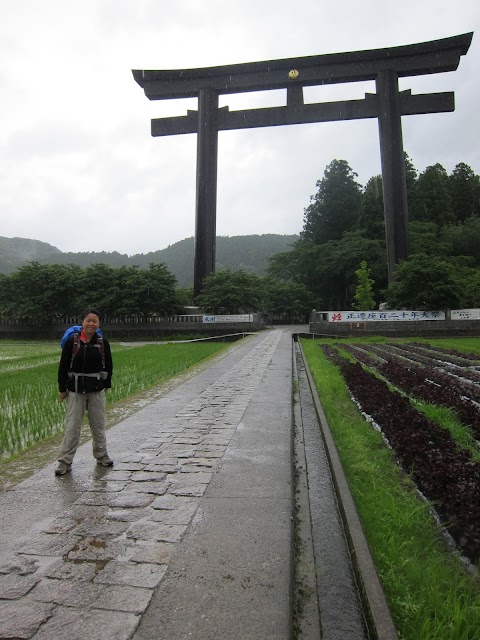
Kumano Hongu Taisha grand shrine.
This was the entrance to the original temple site. The grounds are considered sacred and seasonal festivals still take place. The villagers and monks moved the temple up the hill in the last 100 years. The grounds felt so quiet, rich with energy and life. Photographs are not allowed inside the temple itself but these shots give you a tiny taste.

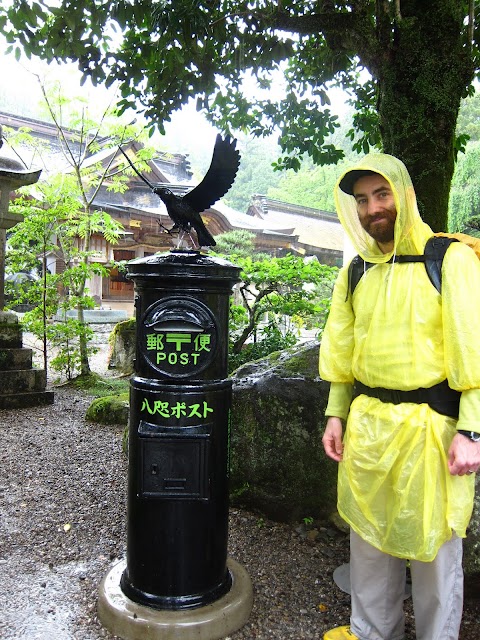
Special raven mailbox. The crow is the sacred religious icon for this region, the three-legged crow is particularly holy.
For more on the story of the sacred raven look here
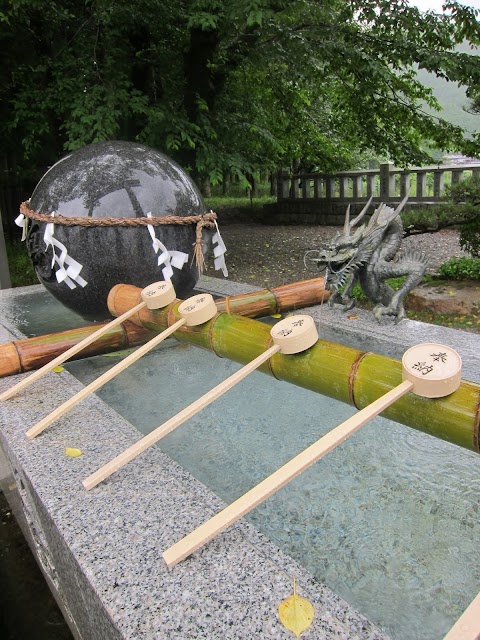
Ladles for self-purification before entering the Shrine grounds
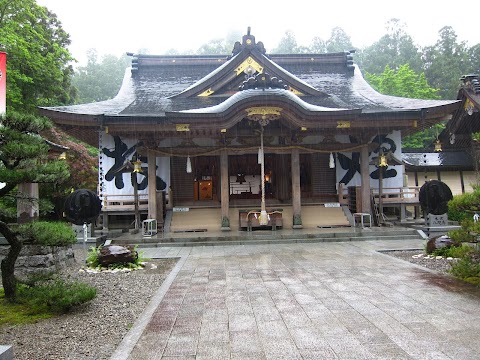
Entrance shrines at Hongu Taisha
We find some tasty treats to relax inside and hide from the rain. The Wakayama prefecture prides themselves on orange cultivation, over 70 varieties are grown in the region. The only varieties we found for sale may have been known for essential oils, and fragrance. When we ate oranges, the insides were stringy and sour. The zest however was thick and sweet smelling.
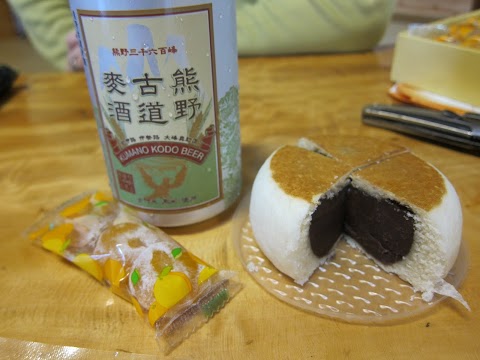
Delicious regional orange candy, red bean cake, and Kumano Kodo Beer, a special brew for the region/trail, and the best beer of Japan.
After Kumano Hongu Taisha, we took the bus to Koguchi to spend the night near the trail head for the next day’s hike. Mags used her Chinese reading skills to notice signs for a guest house. One would otherwise not notice it, as it is basically a house, in which an older couple rents out two rooms. In fact, you should probably call ahead. This may be the only lodging in town. We were fortunate that one of the two rooms was available when we arrived. Note: do not try to bargain. The price is firm 🙂
There is a small general store in town where you may purchase items to prepare for dinner using the water heater. An excellent breakfast is provided by the hosts in the morning.

breakfast at the guest house in Koguchi

hand crank phone
Along the trail, we saw snakes, lizards, and crabs from the river. Most of the crabs we saw were dead. For a while, we couldn’t figure out where they were coming from, all the way up in the mountains. Stu was convinced a practical joker planted them there. But of course they came from the river.
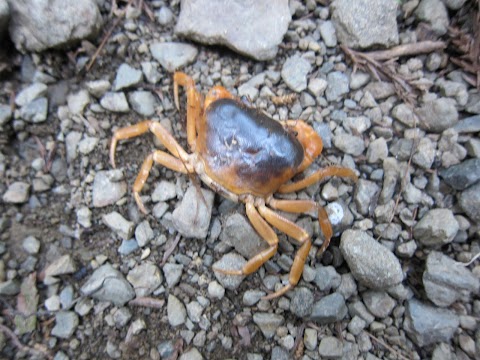
mountain crabs of the Wakayama forest province
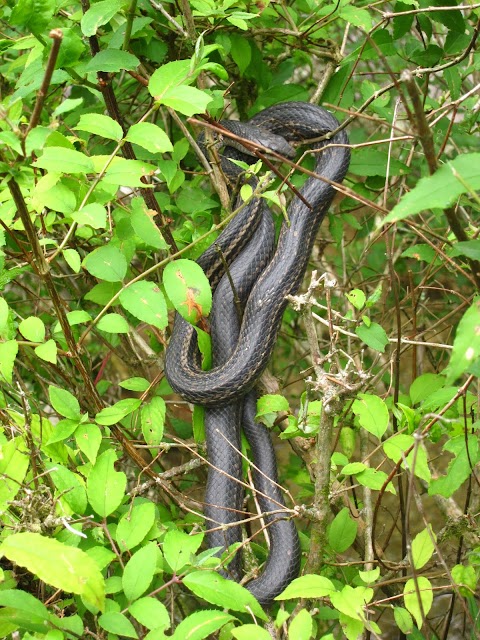
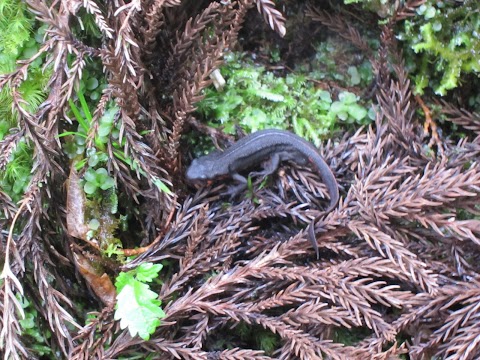
We then set out for Kumano Nachi Taisha. This was a much larger shrine and town than the others. I would definitely call ahead and make a reservation at this one, because this is the only place where our “wing it” strategy didn’t work.
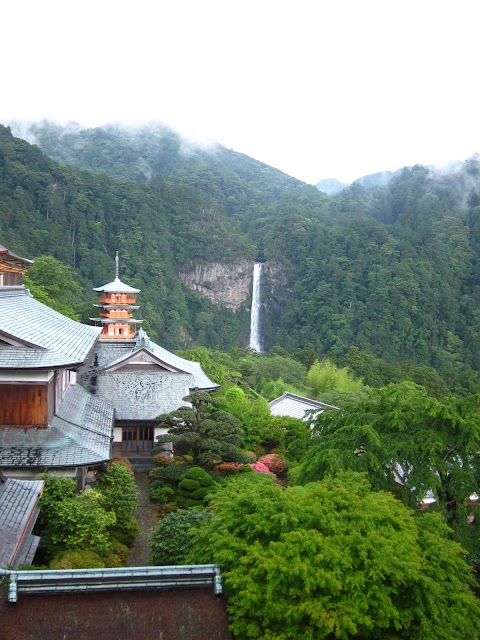
This place was incredibly beautiful. Think Rivendell from Lord of the Rings. Beautiful Japanese temple town on a steep stone cliffs with mountain waterfalls in the background. Nachi Falls are one of the tallest falls in the world at 133 meters. We had read that you can sleep in the temple for a low price after 5pm. However, we arrived at 3pm and we couldn’t speak enough Japanese to find out more information. We walked down many flights of stairs through the scenic grounds to the guest house in town. Unfortunately, there were no rooms available for us, so we could only briefly enjoy the beauty of this area.
We hopped on a bus, intending to head down to the next town that had a train station. However, Mags noticed a guest house on the map, which was on the bus route before the train station. So we got off early, and walked down a suburban street that ended in a public garden and historic site. We found the place, and knocked on the door, only to be greeted by a very confused older Japanese woman. Her husband also joined in the “discussion,” as there wasn’t a common language shared by the two parties.
It turns out that their house used to be a guest house… a hundred years ago. Now the map just referred to it as a historical point of interest. Oops! The good news was that the gentleman offered to drive us to the nearest hotel, which was about 20 minutes away.
We were certainly a bit disappointed that we weren’t able to spend more time in Kumano Nachi Taisha, but at the same time we were blown away by the generosity of the gentleman who drove us to our hotel. And, in fact, we had a great time in the working-class fishing town of Kii Katsuura.
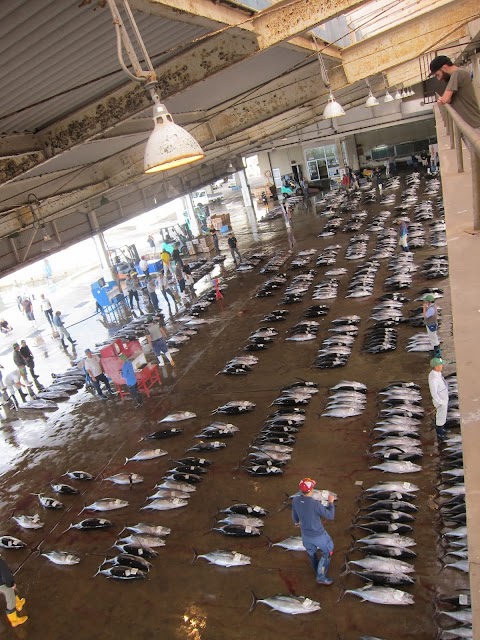
We found this fish market in Kii Katsuura, which had a public access viewing deck above.
We attempt to spend a day at a sandy white beach with aqua waters of the Pacific, miss a turn and find ourselves in the cold yet beautiful bay instead.
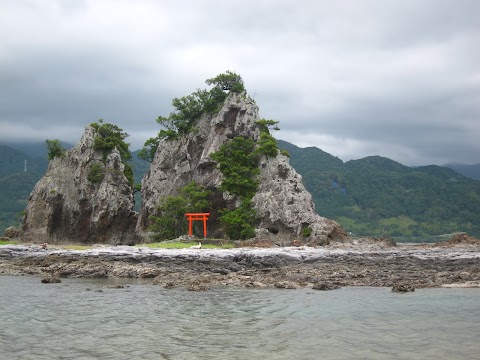
On a walk in Kii Katsuura, we found a rocky beach island with a shrine, which I suppose you could access at low tide.
Throughout our Kumano Kodo hike, we were surrounded by amazing views of nature, near and far.
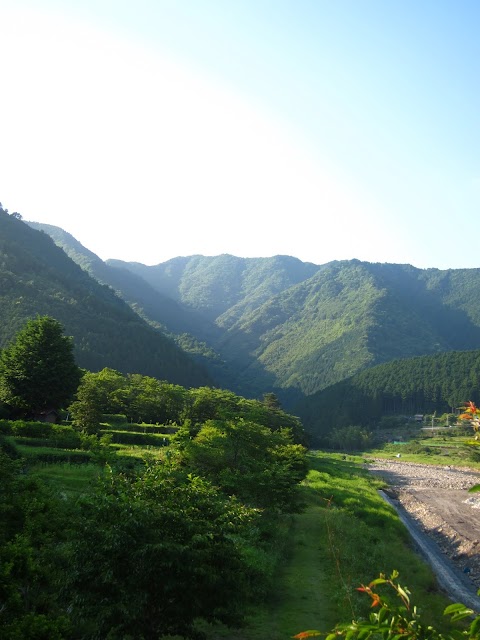
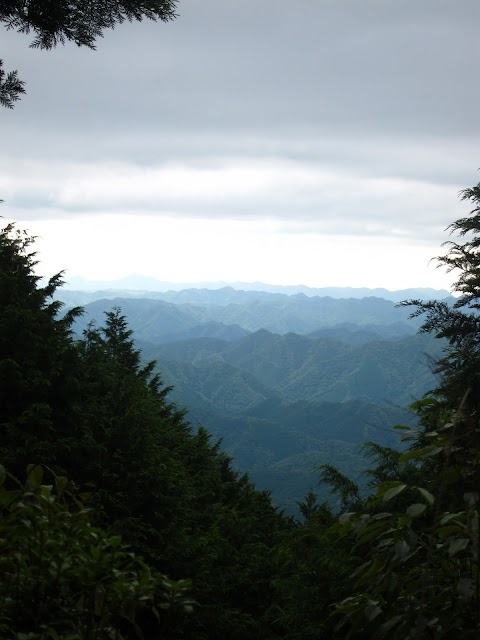
We also came across many old shrines, sculptures, historical ruins, and signs with tales of retired emperors on their pilgrimages.
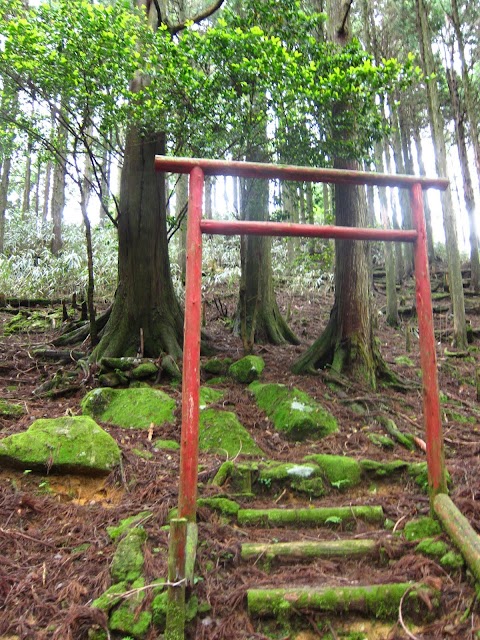
Small shrines like this were common on the trail.
The archway denotes sacred land. In the mountain religion, all things of nature are sacred; rocks, trees, mountains, streams and earth all embody God.
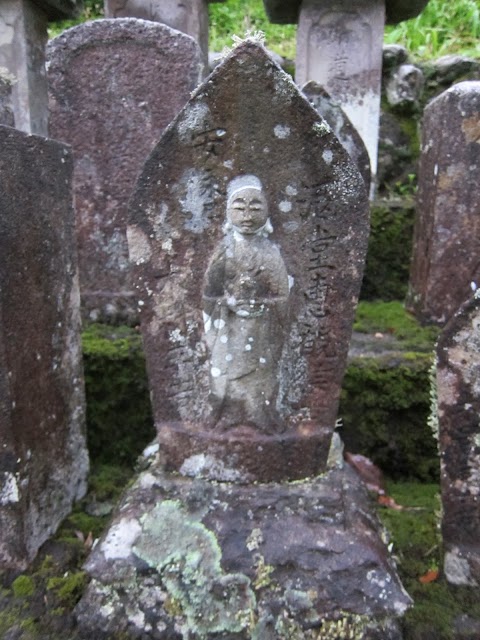
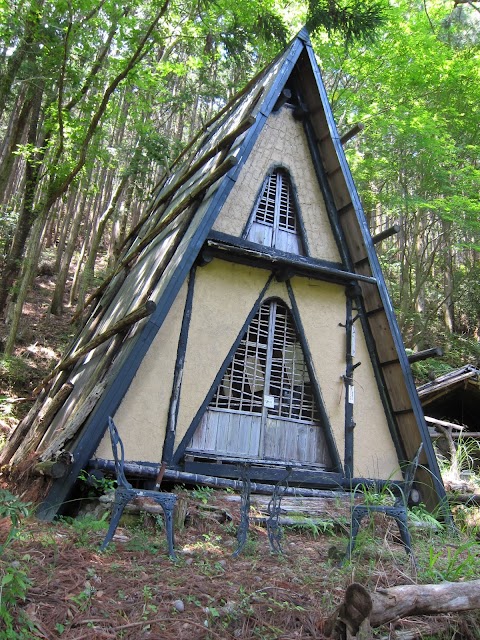
I would recommend hiking the Kumano Kodo trail to almost anyone. And, in fact, I really hope we get to hike it ourselves again sometime.
Just a few tips from experience for the Kumano Kodo hiker:
- Pack light. I’d recommend two sets of clothes, a first aid kit, a camera, cash (not credit), plenty of water, and enough food for two lunches and snacks. You should be able to eat dinner and breakfast in town, and resupply your trail food in town. There may not be potable water during your hike.
- Plan one day ahead. Like us, you may find yourself wanting to take one day off unexpectedly, but at the same time you don’t want to unexpectedly find yourself without a place to sleep in the town you wanted.
For the full set of pictures from this portion of our trip, click here.

